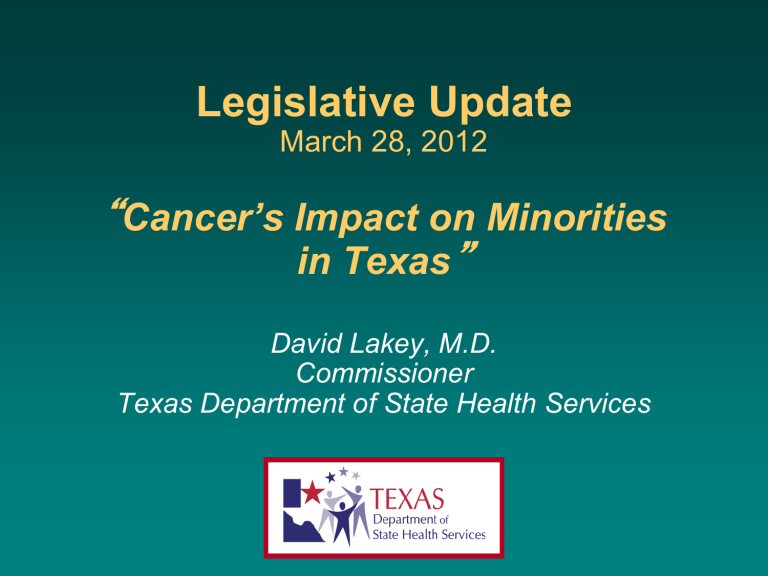MinorityCancerAwareness-032712 - Texas Department of State

Legislative Update
March 28, 2012
“
Cancer’s Impact on Minorities in Texas
”
David Lakey, M.D.
Commissioner
Texas Department of State Health Services
Life Expectancy in Texas
Total and by Race
(1989 – 2009)
2
10 Leading Causes of Death in Texas (2009)
6
7
4
5
Rank Cause
1 Heart Diseases
2
3
Malignant Neoplasms
Accidents
Cerebrovascular Diseases
Chronic Lower Respiratory Diseases
Alzheimer's Disease
Diabetes Mellitus
8 Nephritis, Nephrotic Syndrome, Nephrosis
9
10
# of Deaths
38,008
35,531
9,310
9,118
8,624
5,062
4,866
3,688
Influenza And Pneumonia
Septicemia
3,380
3,085
Deaths from all causes 162,792
Ten leading causes account for
% of All Deaths
23.3%
21.8%
5.7%
5.6%
5.3%
3.1%
3.0%
2.3%
2.1%
1.9%
75.3%
3
Actual Causes of Death
Shaped by Behavior
Tobacco
Overweight/Obesity
Alcohol
Auto Accidents
Drugs
Suicide
DWI
Homicide
Sexual Behavior
0 5000 10000 15000 20000 25000 30000
4
Chronic Disease in Texas 2007, DSHS
Cancer Facts
• In 2012, more than 110,000 Texans will likely be diagnosed with cancer.
• Over 39,000 Texans will die from cancer.
• The total annual cost associated with cancer in the state is estimated to be $28 billion.
– This includes medical care, as well as indirect costs due to lost productivity from illness and premature death.
5
Cancer in Texas
• Lung cancer remains the leading cause of cancer deaths, killing an average of 9,641 Texans (2005 – 2009).
• Breast cancer is the most common cancer among Texas women.
– Only 70% of women age 40+ have a mammogram in the past 2 years.
• Cervical cancer is one of the most preventable and detectable through regular screening.
– Only 76% of women 18+ were screened in the past 3 years.
• In Texas, colorectal cancer is the 3 rd most common cancer in men & women & the 2 nd leading cause of death.
– Only 53% of Texans age 50+ have had colorectal screenings.
– The CDC says 60% of colorectal cancers could be prevented through screening.
6
Focus on Four
Cancer Disparities
• Lung Cancer
• Breast Cancer
• Cervical Cancer
• Colorectal Cancer
7
Lung Cancer Incidence Rate
by Sex & Race/Ethnicity Texas 2005-2009
140
120
100
80
60
90
116
*
59
53
49
Males
Females
40
20
0
Non-Hispanic White
25
40
28
Black Hispanic Asian/Pacific Islander
* Rate is statistically significantly higher than the rate of Non-Hispanic Whites.
Rates are average annual rates per 100,000, age-adjusted to the 2000 U.S. Standard Population.
Lung Cancer Mortality Rate
by Sex & Race/Ethnicity Texas 2005-2009
100
90
80
70
60
50
40
30
20
10
0
69
43
Non-Hispanic White
93
*
39
35
15
30
19
Males
Females
Black Hispanic Asian/Pacific Islander
* Rate is statistically significantly higher than the rate of Non-Hispanic Whites.
Rates are average annual rates per 100,000, age-adjusted to the 2000 U.S. Standard Population.
Lung Cancer Disparities
• Cigarette smoking is the number one risk factor for lung cancer, causing about 90% of all U.S. lung cancers.
• Lung cancer was diagnosed in black males at a rate almost 1/3 greater than that of white males.
• As with lung cancer incidence, black men also have higher mortality rates, at a rate 1/3 greater than non-Hispanic white men.
• Among Texas women, white women were diagnosed with and died from lung cancer at rates higher than other race/ethnic groups in Texas.
10
Adult Smokers
Race and Ethnicity
Female Breast Cancer
Incidence Rates by Race/Ethnicity
Texas 2005-2009
140
120
100
80
60
40
20
0
124
Non-Hispanic White
119
93
63
Black Hispanic Asian/Pacific Islander
Rates are average annual rates per 100,000, age-adjusted to the 2000 U.S. Standard Population
.
12
Female Breast Cancer
Mortality Rates by Race/Ethnicity
Texas 2005-2009
40
35
30
25
20
15
10
5
0
22
Non-Hispanic White
34
*
Black
17
Hispanic
9
Asian/Pacific Islander
* Rate is statistically significantly higher than the rate of Non-Hispanic Whites.
Rates are average annual rates per 100,000, age-adjusted to the 2000 U.S. Standard Population.
13
Breast Cancer Disparities
• Even though black women were diagnosed at a lower rate than white women:
– Black women died from breast cancer at a rate 50% higher than whites
• Possible Explanations:
– Lack of health care coverage,
– Less access to mammography, and
– Potentially unequal access to improvements in cancer treatment.
• Research shows that black women are more likely to develop aggressive breast tumors at a younger age.
– These aggressive tumors are associated with poorer survival.
14
Cervical Cancer Incidence Rate
by Race/Ethnicity Texas 2005-2009
13
*
10
8
6
4
14
12
8
2
0
Non-Hispanic White
10
*
Black Hispanic
5
Asian/Pacific Islander
* Rate is statistically significantly higher than the rate of Non-Hispanic Whites.
Rates are average annual rates per 100,000, age-adjusted to the 2000 U.S. Standard Population.
Cervical Cancer Mortality Rate
by Race/Ethnicity Texas 2005-2009
2,5
2,0
1,5
1,0
0,5
0,0
4,5
4,0
3,5
3,0
2,4
Non-Hispanic White
4.0
*
3.9
*
1,9
Black Hispanic Asian/Pacific Islander
* Rate is statistically significantly higher than the rate of Non-Hispanic Whites.
Rates are average annual rates per 100,000, age-adjusted to the 2000 U.S. Standard Population.
Cervical Cancer Disparities
• While black women had lower cervical cancer incidence rates than Hispanic women
– They had a slightly higher cervical cancer mortality rate than Hispanic women.
• The higher rates in Hispanics and blacks are attributed to lack of:
– Screening due to unequal access to medical care, and
– Cultural and economic barriers to screening.
• The National Immunization Survey-Teen, 2010 estimates that 47.5% of Texans, ages 13-17, received more than one dose of the HPV vaccine.
– The national number is 48.7%
17
Colorectal Cancer Incidence Rates by Sex and Race/Ethnicity
Texas 2005-2009
80
71
*
70
60
50
40
30
52
37
20
10
0
Non-Hispanic White
51
*
Black
50
32
Hispanic
29
26
Asian/Pacific Islander
Males
Females
* Rate is statistically significantly higher than the rate of Non-Hispanic Whites.
Rates are average annual rates per 100,000, age-adjusted to the 2000 U.S. Standard Population.
18
Colorectal Cancer Mortality Rates by Sex and Race/Ethnicity
Texas 2005-2009
40
35
30
25
20
15
10
5
0
20
13
Non-Hispanic White
34 *
22
*
17
10
11
8
Males
Females
Black Hispanic Asian/Pacific Islander
* Rate is statistically significantly higher than the rate of Non-Hispanic Whites.
Rates are average annual rates per 100,000, age-adjusted to the 2000 U.S. Standard Population.
19
Colorectal Cancer Disparities
• Diagnosed in both black males and females at a rate more than 1/3 greater than that of whites.
• Evidence suggests that biological and genetic predisposition may contribute, as well as behavioral factors, such as low-fiber high-fat diets.
• Black Texas men and women died from colorectal cancer
2/3 more often than whites.
• Most colorectal cancer deaths can be prevented through routine screening and early diagnosis.
• Blacks are less likely to complete colorectal cancer screening, resulting in later stage diagnosis.
• Lack of access to screening services and health care coverage may contribute to higher mortality rates.
20
Reducing Disparities
• Prevention and early detection are the best protection.
• Higher screening rates are associated with higher education levels, availability and use of health care, and length of U.S. residence.
21
Recommended Screenings
• The U.S. Preventive Services Task Force
(USPSTF) recommended screenings:
– Breast Cancer: Women aged 50-74 be screened by mammography every 2 years
– Cervical Cancer: Women aged 21-65 be screened by Pap smear every 3 years
– Colorectal Cancer: regular screening of both men and women aged 50-75 by testing or colonoscopy
• Breast, cervical and colorectal cancer screening are now covered in:
– Medicare, and
– In newly offered private insurance plans.
22
Texas Cancer Registry (TCR)
• The TCR collects information, such as types of cancers and locations within the body, extent of cancer, first course treatment, length of survival, and patient characteristics.
• Over 248,000 cancer reports were received in 2009 from over 500 reporters.
• Meets the National Program of Central Cancer Registries, CDC high quality data standards and is Gold Certified by the North American Association of
Central Cancer Registries.
• It is the 4th largest cancer registry in the United States and is recognized by the CDC as 1 of only 10 Comparative Effectiveness Research Specialized
Registries in the nation.
• The TCR assists local, state, national public health officials and policy makers in measuring the Texas cancer burden, comprehensive cancer control efforts, health disparities, progress in prevention, diagnosis, treatment, and survivorship.
23 http://www.dshs.state.tx.us/tcr/default.shtm
Texas Breast & Cervical Cancer
Control Program (BCCS)
• The BCCS goal is to reduce mortality from breast cancer and cervical cancer in Texas.
• BCCS offers clinical breast examinations, mammograms, pelvic examinations, and Pap tests at no or low-cost to eligible women throughout Texas.
Since 1991, the BCCS program has screened 288,434 women for breast or cervical cancer.
Of the 35,911 women seen during the 2010-2011 program year, 14,601 screenings were provided with a total of 325 breast cancers detected.
Of 16,295 cervical screenings were provided through BCCS contractors,
5,488 precancerous conditions & 53 invasive cervical cancers detected
• Access to the state Medicaid program is available for treatment if breast or cervical cancer are diagnosed.
24 http://www.dshs.state.tx.us/bcccs/default.shtm
The Texas Comprehensive
Cancer Control Program
• Texas Comprehensive Cancer Control Program
(CCCP)
– Engages in activities that include minority and underserved populations’ cancer issues.
– CCCP stakeholders work to reach minorities & the underserved.
– A Del Rio cancer coalition (CCCP provides technical assistance) conducts a minority awareness campaign along the border.
– The Cancer Alliance of Texas (CAT), includes organizations focused on disadvantaged populations.
– CAT membership includes the American Cancer Society,
LIVE STRONG , UT MD Anderson Cancer Center, and Susan G. Komen that focus on health disparities, underserved populations, access to clinical trials, and environmental approach initiatives.
25
Smoke Free Ordinances,
Texas
26
Tobacco Funding
• Tobacco prevention/cessation funding reduced 44%
• However, DSHS is actively working toward mitigating this reduction
– DSHS has received a $3M grant over 3 years from the Cancer
Prevention Research Institute of Texas (CPRIT)
– DSHS will continue to provide Texas Quitline telephone counseling services and Nicotine Replacement Therapy to priority populations at high risk for tobacco addiction o This includes the uninsured, treatment for addictions to alcohol or drugs, and individuals referred to the Quitline by their clinician o DSHS estimates grants funds will provide services to ~7000 callers annually, of whom 70% will receive counseling and 30% will receive
NRT http://www.dshs.state.tx.us/tobacco/ 27
What Helps Smokers Quit?
• Texas Quitline 1-877-YES QUIT
• Comprehensive Community Coalition
Intensive Interventions supported by:
– Mass Media Campaign in 15 of 254 Texas Counties
– Resulted in 8 times more calls to the Quitline than in counties with no interventions.
• Medicaid Funding for Quitline and Rx Benefit for Cessation Medication
28
Conclusion
• Health disparities in cancer incidence and mortality can be reduced by 2 key strategies:
– Prevention
• Smoking cessation
• Healthy diets
• Regular exercise
– Early detection
• Increased awareness about the need for screenings
• Improved access to recommended screenings
29









